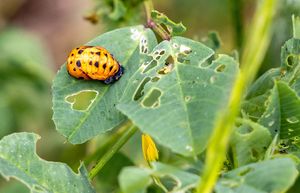Ladybugs, often seen as charming garden guests, undergo a remarkable transformation throughout their life cycle. This metamorphosis entails significant physical changes, transitioning from egg to larva, to pupa, and finally to adult. This fascinating process, described by insect scientist Rich Zack from Washington State University, highlights the intricacies of nature.
The life cycle of a ladybug begins with the laying of eggs, typically found in clusters on the underside of leaves. These eggs are usually yellow or orange and resemble tiny grains of rice. Within a few days, they hatch into larvae. These spiny creatures are voracious eaters, often consuming leftover eggs from their mother and, at times, even their slower siblings. Once they have exhausted those resources, they turn their attention to soft-bodied insects, such as aphids.
As the larva grows, it experiences several stages of molting. Each time the cuticle, or tough outer skin, becomes too tight, the larva sheds it and emerges with a new, larger cuticle. This process is known as an “instar,” and a typical ladybug larva may go through several instars before it is ready to transform into an adult.
After a few weeks, the larva reaches its final stage before adulthood. It sheds its cuticle one last time, remaining inside to form a hard pupal case that adheres to a leaf or other surface. Inside this case, the larva’s body undergoes extensive reorganization. After about a week, an adult ladybug emerges, fully formed and ready to fulfill its role in nature.
The concept of complete metamorphosis, which ladybugs exhibit, is classified scientifically as holometabolous. This contrasts with the life cycles of about a third of insects that experience a partial metamorphosis, known as hemimetabolous, which includes three stages: egg, nymph, and adult. Nymphs resemble adults but lack wings and reproductive organs, only acquiring these features at their final molt.
Moreover, the rarest life cycle is that of ametabolous insects, which do not undergo any metamorphosis. In these cases, juveniles closely resemble adults but are simply smaller. Remarkably, these insects have remained largely unchanged for millions of years.
The evolutionary advantages of complete metamorphosis remain a topic of interest among scientists. Some suggest that this adaptation allows juvenile and adult insects to avoid competition for resources, while others propose it could enhance wing development.
As Rich Zack aptly stated, “It’s so complicated and so vulnerable. We see changes in other animals but nothing like this. It’s just amazing.” The intricate life cycle of ladybugs serves as a testament to the wonders of nature, showcasing an adaptation that continues to intrigue researchers and nature enthusiasts alike.
Parents and educators can guide children in exploring more questions about nature through the Ask Dr. Universe platform at askdruniverse.wsu.edu/ask.





































































